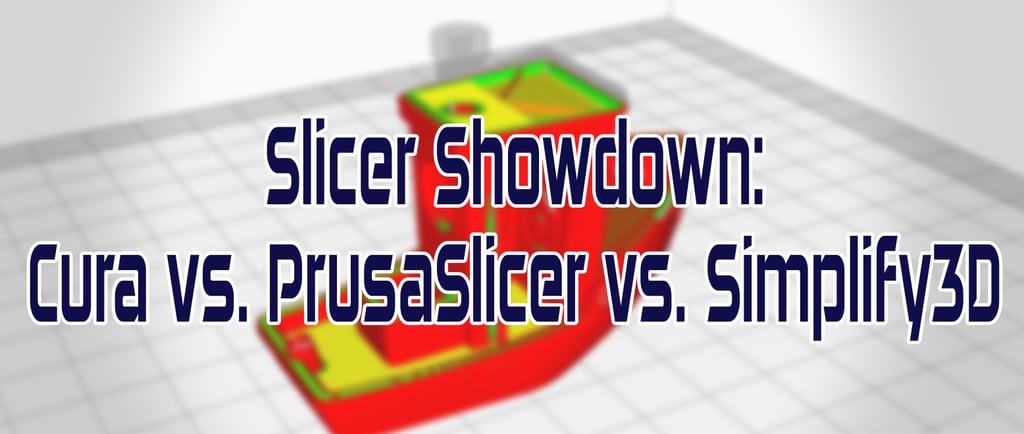Slicer Showdown: Cura vs. PrusaSlicer vs. Simplify3D - Which Reigns Supreme? (An In-Depth Analysis)
COMPARISON
3/25/20254 min read


The journey from a digital 3D model to a tangible object hinges on the crucial intermediary: the slicer software. This software meticulously dissects your design, generating the g-code instructions that guide your 3D printer. With a vast array of slicers available, selecting the right one can be a daunting task. Today, we'll embark on an extensive exploration of three prominent contenders: Cura, PrusaSlicer, and Simplify3D, dissecting their strengths, weaknesses, and suitability for various user profiles.
Cura: The Community-Driven Powerhouse
Cura, developed by Ultimaker, has long been a favorite among 3D printing enthusiasts. Its open-source nature and active community contribute to its continuous development and widespread adoption.
Interface and Usability:
Cura's interface is designed with user-friendliness in mind. The "Basic" mode simplifies the slicing process for beginners, offering essential settings with clear explanations.
The "Advanced" mode unlocks a plethora of customizable parameters, allowing experienced users to fine-tune every aspect of their prints.
The layout is intuitive, with clearly labeled menus and tooltips that guide users through the various settings.
Feature Deep Dive:
Cura's plugin system is a major advantage, enabling users to extend its functionality with custom features and integrations.
It offers a wide range of infill patterns, support structures, and advanced settings for optimizing print quality and strength.
The "Experimental" settings provide access to cutting-edge features and algorithms, allowing users to explore the latest advancements in slicing technology.
Material Profiles and Compatibility:
Cura boasts a vast online library of material profiles, contributed by users and manufacturers alike.
It supports a wide range of 3D printers and filaments, making it a versatile choice for diverse setups.
Users can easily create and share custom material profiles, fostering a collaborative environment.
Speed and Efficiency:
Cura's slicing algorithms have improved significantly over time, but it may not always be the fastest option for complex models.
It offers various optimization settings for reducing print times, such as adaptive layer height and infill density adjustments.
Community and Support:
Cura's large and active community provides ample support through forums, tutorials, and online resources.
Ultimaker offers official documentation and support, ensuring users have access to reliable information.
PrusaSlicer: Precision and Performance for Prusa Users
PrusaSlicer, developed by Prusa Research, is tailored for Prusa 3D printers but also supports a wide range of other machines. It's known for its precision and efficiency, particularly for complex prints.
Interface and Usability:
PrusaSlicer's interface is well-organized, but it can initially feel more complex than Cura due to its extensive feature set.
Helpful tooltips and detailed explanations guide users through the various settings.
The "Expert" mode provides granular control over print parameters, catering to advanced users.
Feature Deep Dive:
PrusaSlicer excels in its fine-tuned control over print parameters, particularly for Prusa printers.
It offers advanced features like variable layer height, adaptive infill, and precise support structure generation.
The "Sequential Printing" feature allows users to print multiple objects one after another, minimizing travel moves and reducing print times.
Material Profiles and Compatibility:
PrusaSlicer is tightly integrated with Prusa printers, providing optimized profiles for various Prusa filaments.
It also supports a growing library of third-party materials, offering flexibility for users with diverse filament collections.
Users can easily import and export material profiles, facilitating sharing and collaboration.
Speed and Efficiency:
PrusaSlicer is renowned for its efficient g-code generation, often resulting in shorter print times compared to other slicers.
Its optimized toolpaths and advanced algorithms contribute to faster print speeds and reduced material waste.
Community and Support:
Prusa Research provides excellent documentation and support, ensuring users have access to reliable information.
The Prusa community is active and helpful, offering assistance through forums and online resources.
Simplify3D: The Professional's Choice
Simplify3D is a commercial slicer known for its advanced features, granular control, and professional-grade performance. It's often favored by experienced users who demand maximum customization.
Interface and Usability:
Simplify3D's interface is designed for professional use, offering a high degree of customization and control.
It may present a steeper learning curve for beginners due to its advanced features and extensive settings.
It offers a very detailed and very precise control over every part of the printing process.
Feature Deep Dive:
Simplify3D excels in its granular control over every aspect of the printing process, allowing for highly customized print profiles.
It's known for it's very good support generation.
It offers advanced features like custom support structures, optimized toolpaths, and detailed print preview.
It also allows for very precise control over the gcode, allowing for very specific modifications.
Material Profiles and Compatibility:
Simplify3D allows for highly customized material profiles, but users may need to create or import profiles manually.
It supports a wide range of 3D printers, but users may need to configure their printer settings manually.
Speed and Efficiency:
Simplify3D's advanced algorithms can generate highly optimized toolpaths, potentially reducing print times compared to other slicers.
It often produces very high quality gcode.
Community and Support:
Simplify3D offers professional support, but its community is smaller compared to Cura and PrusaSlicer.
It is a paid software, and it's updates are less frequent than the other two.
The Ultimate Verdict: Tailoring Your Choice to Your Needs
The "best" slicer ultimately depends on your individual needs, experience level, and printer setup.
Cura: Ideal for beginners and those seeking a user-friendly experience with wide compatibility and a large community.
PrusaSlicer: A powerful option for Prusa printer users, offering excellent control, efficiency, and optimized profiles. Also a great option for advanced users.
Simplify3D: Best suited for advanced users and professionals who demand granular control, highly customized print profiles, and optimized toolpaths.
By carefully considering these factors, you can select the slicer that empowers you to bring your 3D printing visions to life with precision, efficiency, and ease.